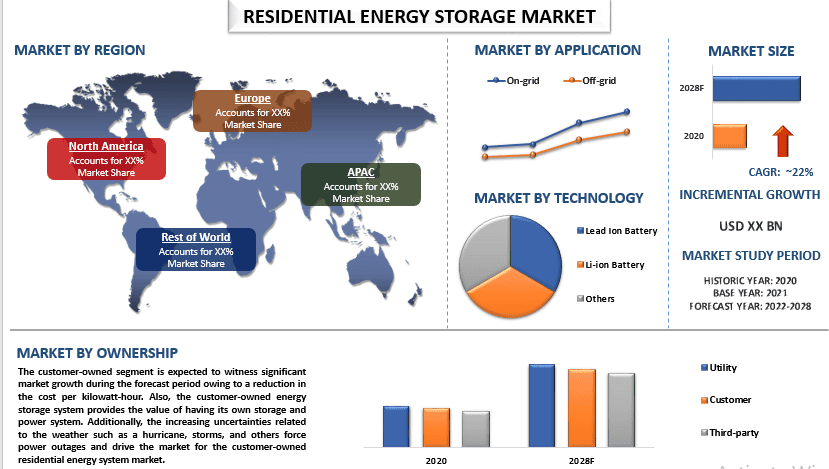- Home
- About Us
- Industry
- Services
- Reading
- Contact Us
Residential Energy Storage Market: Current Analysis and Forecast (2022-2028)
Emphasis on Technology (Lead ion Battery, Li-ion Battery, and Others); Application (On-Grid and Off-Grid); Ownership (Utility, Customer, and Third Party); and Region/Country

Global Residential Energy Storage Market is expected to grow at a significant rate of around 22% during the forecast period. Residential energy storage systems are made up of a collection of batteries that allow the extra electricity to be used at a later time. Due to the rising energy demand, deteriorating electrical infrastructure, and the need to maintain grid stability, the residential energy storage industry has experienced significant demand. Additionally, for performance optimization and lower operating costs, the household energy storage system could be combined with renewable energy sources like solar, wind, and other resources. Additionally, the home energy storage system permits energy self-consumption while supplying power at a reduced voltage.
Tesla, Sonnen GmbH, Panasonic Industry, Enphase Energy, VARTA AG, ABB, Siemens AG, Eguana Technologies, BYD Company Ltd., and Eaton are some of the key players in the market. Several M&As along with partnerships have been undertaken by these players to facilitate customers with hi-tech and innovative products/technologies.
Insights Presented in the Report
“Amongst application, on-grid category to witness higher CAGR during the forecast period”
Based on application, the market is bifurcated into the on-grid and off-grid segments. The on-grid segment is expected to witness significant CAGR during the forecast period owing to its increasing utilization in residential buildings. Also, on-grid energy storage also allows for the delivery of excess energy to the utility that controls the grid, and energy is directly stored in the system of the power generating plant. Furthermore, it is expected that in the near future, the market for on-grid home energy storage would grow as a result of technological developments such as solar PV panels, hydrogen/SNG, and electrochemical batteries.
“Amongst technology, the Li-ion battery to hold a significant share in the market in 2020”
On the basis of technology, the market is segmented into lead ion battery, Li-ion battery, and others. The Li-ion battery segment is expected to witness significant market growth during the forecast period due to its high energy density, longer durability, and constant power supply. In addition, compared to conventional batteries, Li-ion batteries have a lower self-discharging rate and require less maintenance. Additionally, Li-ion batteries don’t need priming and each cell is approximately 3.6V, which is relatively greater than conventional batteries. Additionally, it is expected that the market would rise during the forecast period due to rising government support and investment in the production of Li-ion batteries.
“Asia-Pacific to hold a significant share in the market”
In 2020, Asia-Pacific held a significant share of the global residential energy storage market. This is mainly attributed to the rapid urbanization and increasing demand for electricity in the region. Also, the growing investment for the upgradation of grid infrastructure, advancement in battery technology, and several government incentives to promote the residential energy storage system is expected to support the market growth in the region. Additionally, it is expected that throughout the forecast period, the market expansion in the region would be fueled by falling Li-ion battery prices, cheaper manufacturing and production costs, and lower labor expenses. For instance, in June 2022, Toyota launched a residential 5.5kWh battery storage system that is capable to deliver the required output and could be connected to the PV rooftop solar installations.
Reasons to buy this report:
- The study includes market sizing and forecasting analysis validated by authenticated key industry experts.
- The report presents a quick review of overall industry performance at one glance.
- The report covers an in-depth analysis of prominent industry peers with a primary focus on key business financials, product portfolio, expansion strategies, and recent developments.
- Detailed examination of drivers, restraints, key trends, and opportunities prevailing in the industry.
- The study comprehensively covers the market across different segments.
- Deep dive regional level analysis of the industry.
Customization Options:
The global residential energy storage market can further be customized as per the requirement or any other market segment. Besides this, UMI understands that you may have your own business needs, hence feel free to connect with us to get a report that completely suits your requirements.
Table of Content
Research Methodology for the Residential Energy Storage Market Analysis (2022-2028)
Analyzing the historical market, estimating the current market, and forecasting the future market of the global residential energy storage market were the three major steps undertaken to create and analyze the adoption of residential energy storage in major regions globally. Exhaustive secondary research was conducted to collect the historical market numbers and estimate the current market size. Secondly, to validate these insights, numerous findings and assumptions were taken into consideration. Moreover, exhaustive primary interviews were also conducted, with industry experts across the value chain of the global residential energy storage market. Post assumption and validation of market numbers through primary interviews, we employed a top-down/bottom-up approach to forecasting the complete market size. Thereafter, market breakdown and data triangulation methods were adopted to estimate and analyze the market size of segments and sub-segments of the industry pertains to. Detailed methodology is explained below:
Analysis of Historical Market Size
Step 1: In-Depth Study of Secondary Sources:
Detail secondary study was conducted to obtain the historical market size of the residential energy storage market through company internal sources such as annual reports & financial statements, performance presentations, press releases, etc., and external sources including journals, news & articles, government publications, competitor publications, sector reports, third-party database, and other credible publications.
Step 2: Market Segmentation:
After obtaining the historical market size of the residential energy storage market, we conducted a detailed secondary analysis to gather historical market insights and share for different segments & sub-segments for major regions. Major segments are included in the report as technology, application, and ownership. Further country-level analyses were conducted to evaluate the overall adoption of testing models in that region.
Step 3: Factor Analysis:
After acquiring the historical market size of different segments and sub-segments, we conducted a detailed factor analysis to estimate the current market size of the residential energy storage market. Further, we conducted factor analysis using dependent and independent variables such as various technology, application, and ownership of residential energy storage. A thorough analysis was conducted for demand and supply-side scenarios considering top partnerships, mergers and acquisitions, business expansion, and product launches in the residential energy storage market sector across the globe.
Current Market Size Estimate & Forecast
Current Market Sizing: Based on actionable insights from the above 3 steps, we arrived at the current market size, key players in the global residential energy storage market, and market shares of the segments. All the required percentage shares split, and market breakdowns were determined using the above-mentioned secondary approach and were verified through primary interviews.
Estimation & Forecasting: For market estimation and forecast, weights were assigned to different factors including drivers & trends, restraints, and opportunities available for the stakeholders. After analyzing these factors, relevant forecasting techniques i.e., the top-down/bottom-up approach were applied to arrive at the market forecast for 2028 for different segments and sub-segments across the major markets globally. The research methodology adopted to estimate the market size encompasses:
- The industry’s market size, in terms of revenue (USD) and the adoption rate of the residential energy storage market across the major markets domestically
- All percentage shares, splits, and breakdowns of market segments and sub-segments
- Key players in the global residential energy storage market in terms of products offered. Also, the growth strategies adopted by these players to compete in the fast-growing market
Market Size and Share Validation
Primary Research: In-depth interviews were conducted with the Key Opinion Leaders (KOLs) including Top Level Executives (CXO/VPs, Sales Head, Marketing Head, Operational Head, Regional Head, Country Head, etc.) across major regions. Primary research findings were then summarized, and statistical analysis was performed to prove the stated hypothesis. Inputs from primary research were consolidated with secondary findings, hence turning information into actionable insights.
Split of Primary Participants in Different Regions

Market Engineering
The data triangulation technique was employed to complete the overall market estimation and to arrive at precise statistical numbers for each segment and sub-segment of the global residential energy storage market. Data was split into several segments & sub-segments post studying various parameters and trends in the areas of technology, application, and ownership in the global residential energy storage market.
The main objective of the Global Residential Energy Storage Market Study
The current & future market trends of the global residential energy storage market were pinpointed in the study. Investors can gain strategic insights to base their discretion for investments on the qualitative and quantitative analysis performed in the study. Current and future market trends determined the overall attractiveness of the market at a regional level, providing a platform for the industrial participant to exploit the untapped market to benefit from a first-mover advantage. Other quantitative goals of the studies include:
- Analyze the current and forecast market size of the residential energy storage market in terms of value (USD). Also, analyze the current and forecast market size of different segments and sub-segments.
- Segments in the study include areas of technology, application, and ownership.
- Define and analysis of the regulatory framework for the residential energy storage
- Analyze the value chain involved with the presence of various intermediaries, along with analyzing customer and competitor behaviors of the industry.
- Analyze the current and forecast market size of the residential energy storage market for the major region.
- Major countries of regions studied in the report include Asia Pacific, Europe, North America, and the Rest of the World.
- Company profiles of the residential energy storage market and the growth strategies adopted by the market players to sustain in the fast-growing market
- Deep dive regional level analysis of the industry
Related Reports
Customers who bought this item also bought










